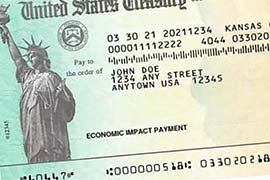- Slug: BC-CNS-Credit Debit,820
- File photo available (thumbnail, caption below)
By Reagan Priest
Cronkite News
WASHINGTON – January was the first month since last summer that Arizona low-income families did not get a check under the expanded Child Tax Credit program, leaving parents scrambling for help and advocates worrying about an increase in poverty.
From July through December, the Treasury Department sent about 795,000 payments a month to Arizona families, an advance on the credit they will get when they file their 2021 taxes. But those payments, which averaged $423 a month nationally, ended in December, after Congress failed to agree on an extension.
“The loss of $300 per child for a household is significant, so I think that families are probably just looking for any resource available to help make ends meet,” said Kelly McGowan, deputy director of Wildfire, an Arizona anti-poverty advocacy group.
She said her organization has seen an increase in the number of people seeking rental assistance since the child tax credit payments stopped coming in.
“We’re still receiving an overabundance of calls for the Emergency Rental Assistance Program,” McGowan said. “Housing costs have been dramatically increasing in Phoenix and all across the state, so people are trying to take advantage of that program to help mitigate those costs and not get evicted.”
The pandemic-relief American Rescue Plan expanded the Child Tax Credit, increasing the maximum annual payments from $2,000 to $3,600 per eligible child and raising eligible age from 16 to 17. It expanded eligibility downward, to include households that earn so little they would not normally file a tax return, and allowed for the first half of the anticipated credit for the year to be distributed in six monthly payments.
More than 1.3 million Arizona children were eligible for the tax credit funding, according to the Treasury, which distributed more than $2.1 billion to families in the state over the six months. Those families were most likely to use it for basics like food, essential bills and clothing or other needs for their children, according to an analysis of Census Bureau data by Washington University and Appalachian State University.
“We’re talking about serious consequences for families that may have been struggling with their usual household expenses, households that might have been in unstable housing, the parents may just be rejoining the labor force and need an extra boost to bridge some of these expenses as they build up their salaries again,” said Andrew Sugrue, the assistant director of policy and advocacy at the Arizona Center for Economic Progress.
Besides the immediate loss of direct aid, advocates are worried about the impact the loss of the tax credit will have on the long-term poverty rate. A study by the Center on Budget and Policy Priorities estimated that the number of children in poverty could have fallen by as much as 40% with the monthly payments.
Even if the program can be started up again, the lapse in payments will disrupt the gains that had been made in assisting those who need it most, said Zach Tilly, a policy associate with Children’s Defense Fund.
“And that’s a shame because we know that if the program is extended and monthly payments reach every eligible kid then you get to a place where this program is potentially reducing child poverty by 40 or 50%,” said Tilly, who called the tax credit the most effective anti-poverty policy in recent history.
A proposal to extend payments through 2022 was part of the Biden administration’s Build Back Better budget reconciliation, but that bill stalled in the Senate in December.
Tilly said that in order to continue to reduce child poverty and benefit children in the long run, the tax credit payments need to be extended not just through the end of 2022, but permanently.
“Without these monthly cash benefits that the CTC provides it’s an uphill battle to put together a suite of policies that gets you the same kind of child poverty reduction that the CTC gets you,” he said.
Families will still get the second half of their child tax credit payment when they file taxes in the spring. But advocates say that for families who relied on the monthly payments to stay afloat, the gap puts them in a precarious position.
“With so much uncertainty right now, the CTC payments offered a level of predictability for families to know that they were going to have this source of income boost over the course of the year,” Sugrue said.
While the federal payment program has stalled, McGowan said local advocates are looking toward a promise made by Gov. Doug Ducey in his 2023 budget proposal that would establish a state earned-income tax credit, rewarding taxpayers with an estimated $128 annually.
“We’re really hoping that that is something that moves forward, and certainly something we’re advocating for in this legislative session, because that would function like a Child Tax Credit, so just some additional money in the hands of low-income families to help afford their basic needs,” McGowan said.
For more stories from Cronkite News, visit cronkitenews.azpbs.org.
^__=
Web links:
_ CTC spending study: https://assets.aecf.org/m/blogdoc/spi-familiesandctc-AZ-2021.pdf
_ Treasury payments: https://home.treasury.gov/system/files/131/Advance-CTC-Payments-Disbursed-December-2021-by-State-12152021.pdf
_ Child Tax Credit program: https://www.whitehouse.gov/child-tax-credit/
_ Ducey proposal: https://azgovernor.gov/governor/news/2022/01/governor-ducey-releases-budget-focus-education-border-security-and-water
^__=
The expanded federal Child Tax Credit program sent about 795,000 checks a month to low-income families in Arizona from July through December. The payments, more than $2.1 billion in total, ended in December, and advocates worry how the loss will affect families that live paycheck to paycheck. (Photo courtesy U.S. Treasury Department)
